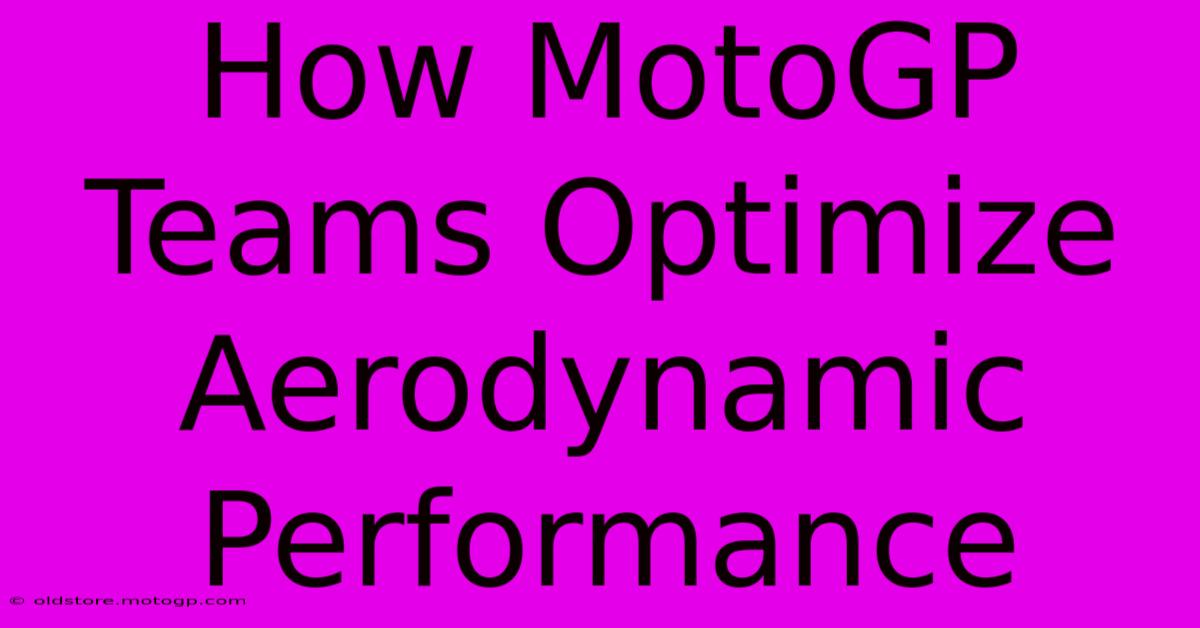How MotoGP Teams Optimize Aerodynamic Performance

Table of Contents
How MotoGP Teams Optimize Aerodynamic Performance
MotoGP, the pinnacle of motorcycle road racing, is a relentless pursuit of speed and efficiency. A crucial element in achieving this is aerodynamic performance. Teams invest heavily in optimizing every aspect of their bikes' aerodynamics, from the smallest winglets to the overall chassis design. This article delves into the sophisticated strategies and technologies employed by MotoGP teams to gain that crucial edge.
Understanding the Aerodynamic Challenges in MotoGP
MotoGP bikes operate at incredibly high speeds, generating significant aerodynamic forces. These forces, both beneficial and detrimental, impact stability, acceleration, braking, and cornering. The challenge lies in harnessing the positive aspects while mitigating the negative ones.
Key Aerodynamic Factors:
- Downforce: Crucial for high-speed stability and cornering grip. Too little downforce leads to instability, while too much increases drag and reduces top speed.
- Drag: Resistance to forward motion, directly impacting top speed. Minimizing drag is paramount for achieving higher velocities on straights.
- Lift: Upward force that reduces contact with the track, compromising grip and stability. Teams actively work to minimize lift, especially at high speeds.
- Yaw: Rotation around the vertical axis, influencing bike stability, especially during braking and cornering. Aerodynamic devices are designed to control yaw and maintain directional stability.
- Pitch: Rotation around the lateral axis affecting the bike’s front and rear attitude and consequently impacting braking and acceleration.
- Roll: Rotation around the longitudinal axis, impacting cornering behavior and stability.
Advanced Techniques for Aerodynamic Optimization
MotoGP teams employ a multifaceted approach to aerodynamic optimization, combining sophisticated computational tools with extensive track testing.
1. Computational Fluid Dynamics (CFD):
CFD simulations are indispensable. These sophisticated computer models analyze airflow around the motorcycle, predicting aerodynamic forces and providing valuable insights for design improvements. Teams can virtually test numerous design variations, identifying optimal configurations before physically prototyping them, saving significant time and resources.
2. Wind Tunnel Testing:
Despite advancements in CFD, wind tunnel testing remains crucial. Physical testing in a wind tunnel allows teams to validate CFD results and refine designs based on real-world data. High-speed cameras and other measurement devices capture detailed airflow patterns, helping engineers understand the impact of different aerodynamic components.
3. Aerodynamic Appendages:
Winglets, fairings, and other aerodynamic devices play a vital role in generating downforce and managing airflow. The design, placement, and angle of these appendages are meticulously optimized. The constant evolution of these components showcases the continuous innovation within MotoGP.
Types of Aerodynamic Devices:
- Winglets: Generate downforce by manipulating airflow, improving stability and cornering grip.
- Fairings: Shape the airflow around the rider and motorcycle, minimizing drag and improving aerodynamic efficiency.
- Underbody Aerodynamics: Optimizing the airflow beneath the bike can significantly reduce drag and improve stability.
4. Rider Position and Suit Design:
Even the rider's position and the design of their leathers contribute to the overall aerodynamic performance. Teams work closely with riders to optimize their posture and utilize specialized suits that minimize drag.
5. Data Acquisition and Analysis:
Extensive data acquisition systems on the bikes collect vast amounts of information during testing and races. This data helps engineers refine aerodynamic models and track the performance of different configurations in real-world conditions. Advanced telemetry systems are key to this process, providing real-time insights.
The Continuous Evolution of Aerodynamic Design
Aerodynamic optimization in MotoGP is an ongoing process. Teams constantly refine their designs based on new data, advancements in technology, and the ever-changing rules and regulations. The relentless pursuit of marginal gains is a key element of success in this highly competitive environment. The subtle changes seen from race to race are a testament to this ongoing iterative design process.
Conclusion:
Optimizing aerodynamic performance is a critical factor in MotoGP success. The combination of sophisticated computational tools, rigorous wind tunnel testing, and meticulous analysis of real-world data allows teams to continually refine their designs, pushing the boundaries of motorcycle technology and performance. The pursuit of aerodynamic excellence remains a central theme in the thrilling and ever-evolving world of MotoGP racing.

Thank you for visiting our website wich cover about How MotoGP Teams Optimize Aerodynamic Performance. We hope the information provided has been useful to you. Feel free to contact us if you have any questions or need further assistance. See you next time and dont miss to bookmark.
Featured Posts
-
Race Bikes For Sale Ride Faster Ride Further
Feb 25, 2025
-
Austin Grand Prix Parking The Only Parking You Ll Need For The Grand Prix
Feb 25, 2025
-
Cota Austin Schedule The Insiders Guide To Race Weekend
Feb 25, 2025
-
Hear From The Experts Moto Gp Commentators Analyze Specific Rider Team
Feb 25, 2025
-
The Science Behind Moto2 Motorcycles
Feb 25, 2025
